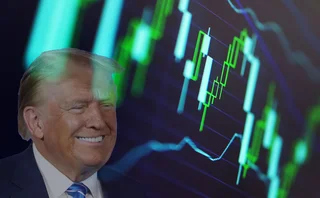
Remembering the range accrual bloodbath
Flatter US yield curve spurs demand for a product with a painful history
For interest rate volatility traders of a certain vintage, the flattening of the lower reaches of the US yield curve has dredged up some unpleasant memories.
When the 10-year point of the euro yield curve plunged below the two-year point in 2008, it produced losses estimated at up to $2.5 billion across the Street, as dealers were forced to rapidly re-hedge their range accrual books – a then-popular structured product that pays investors when the curve is upward sloping between two specified points.
One trader – now on the buy side – recalls being told by his boss’s boss to exit his own position, at the market’s all-time low. He says his bank lost “a few hundred million” in the process: “Exotic desks in Europe collectively lost billions that year, and it took them a very long time to recover from that. They never really fully recovered.”
Those desks may have gone – or be living on in an enfeebled state – but the range accrual product itself never went away. And notes referencing the US rates curve are experiencing a new surge in popularity.
Investors in these products are essentially selling binary options that pay out if the curve inverts and passes through the strike, which is typically set at zero. This is a rare event, but with falling US yields already producing inversions in some stretches of the curve, investors can currently earn a rich coupon for selling these options.
So, it’s no surprise range accruals are flying off the shelves – an exotics trader at one US bank estimates investors bought $4 billion to $5 billion of these notes in January and February, which is double the usual volume.
As 2008 showed, range accruals can be dangerous.
The binary payout of digital options means dealers are long gamma when the forward curve is positive and short gamma when it inverts. Put crudely, this forces them to unwind the steepeners they use to hedge and replace them with flatteners. The result can be a feedback loop, known as a ‘gamma trap’, in which hedging pushes the market against the dealer, forcing them to re-hedge again and again, at significant cost.
When Risk wrote about these products before the 2008 meltdown, some traders were aware of the danger, but downplayed it. Others dismissed it altogether. When the curve inverts, argued one exotics head, “it’s for macroeconomic reasons that have nothing to do with locally re-hedging exotic derivatives books”.
Today, some traders and strategists again downplay the risks. The US rates market is far larger than the euro market in 2008, so there should be less risk of the tail wagging the dog. The products are also more conservatively structured and risk-managed. Most notes reference the widest and most stable part of the curve – between the two- and 30-year points – and the strikes on digital floors have shifted to below zero to give banks more breathing space before they become short gamma.
But not everyone. The former bank trader who was stopped back in 2008 says he is keeping one eye on the market in case there’s a chance for his fund to make back the money he lost a decade ago. And a trading head at one European bank – who remembers the episode well – worries his team lacks that kind of experience. Most of them started trading after the range accrual bloodbath. They should be thinking about the dangers, he says. He’s not sure they are.
Only users who have a paid subscription or are part of a corporate subscription are able to print or copy content.
To access these options, along with all other subscription benefits, please contact info@risk.net or view our subscription options here: http://subscriptions.risk.net/subscribe
You are currently unable to print this content. Please contact info@risk.net to find out more.
You are currently unable to copy this content. Please contact info@risk.net to find out more.
Copyright Infopro Digital Limited. All rights reserved.
As outlined in our terms and conditions, https://www.infopro-digital.com/terms-and-conditions/subscriptions/ (point 2.4), printing is limited to a single copy.
If you would like to purchase additional rights please email info@risk.net
Copyright Infopro Digital Limited. All rights reserved.
You may share this content using our article tools. As outlined in our terms and conditions, https://www.infopro-digital.com/terms-and-conditions/subscriptions/ (clause 2.4), an Authorised User may only make one copy of the materials for their own personal use. You must also comply with the restrictions in clause 2.5.
If you would like to purchase additional rights please email info@risk.net
More on Our take
Why a Trumpian world could be good for trend
Trump’s U-turns have hit returns, but the forces that put him in office could revive the investment strategy
Roll over, SRTs: Regulators fret over capital relief trades
Banks will have to balance the appeal of capital relief against the risk of a market shutdown
Thrown under the Omnibus: will GAR survive EU’s green rollback?
Green finance metric in limbo after suspension sees 90% of top EU banks forgo reporting
Has the Collins Amendment reached its endgame?
Scott Bessent wants to end the dual capital stack. How that would work in practice remains unclear
Talking Heads 2025: Who will buy Trump’s big, beautiful bonds?
Treasury issuance and hedge fund risks vex macro heavyweights
The AI explainability barrier is lowering
Improved and accessible tools can quickly make sense of complex models
Do BIS volumes soar past the trend?
FX market ADV has surged to $9.6 trillion in the latest triennial survey, but are these figures representative?
DFAST monoculture is its own test
Drop in frequency and scope of stress test disclosures makes it hard to monitor bank mimicry of Fed models








